.
7.02.2015
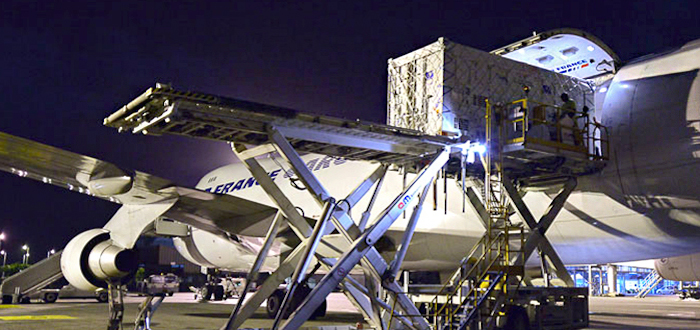
Inside its protective shipping container, one of the two Galileo satellites is unloaded from a Boeing 747 cargo aircraft at French Guiana.
Soyuz Flight VS11
The two Galileo satellite passengers for launch on Arianespace’s next Soyuz flight have now been delivered to French Guiana, enabling the start-up of payload preparations for this medium-lift mission.
Transported by a Boeing 747 cargo jetliner, the pair arrived overnight at Félix Eboué International Airport near the capital city of Cayenne – after which these satellites, protected inside their shipping containers, were unloaded and subsequently moved by road to the Spaceport early this morning.
OHB System built the two Galileo spacecraft in Bremen, Germany as prime contractor. Their navigation payloads, which will generate the precision positioning measurements and services to users worldwide, were supplied by Surrey Satellite Technology Ltd. in Guildford, UK.
The Galileo program is Europe’s initiative for satellite navigation, providing a highly accurate global positioning system under civilian control – to consist of 30 satellites in total, along with European control centers and a worldwide network of sensor and uplink stations.
To deliver highly accurate positioning for most places on Earth, the complete Galileo constellation will be distributed along three circular medium Earth orbit planes at an operational altitude of 23,222 km., inclined 56 deg. to the equator.
The network’s complete operational and ground infrastructure will be deployed during Galileo’s Full Operational Capability phase, which is managed and funded by the European Commission, with the European Space Agency delegated as the design and procurement agent on the Commission’s behalf.
The upcoming mission, designated Flight VS11 in Arianespace’s numbering system, will mark the company’s fourth launch to date with Galileo spacecraft.
Quelle: arianespace
.
Update: 15.02.2015
.
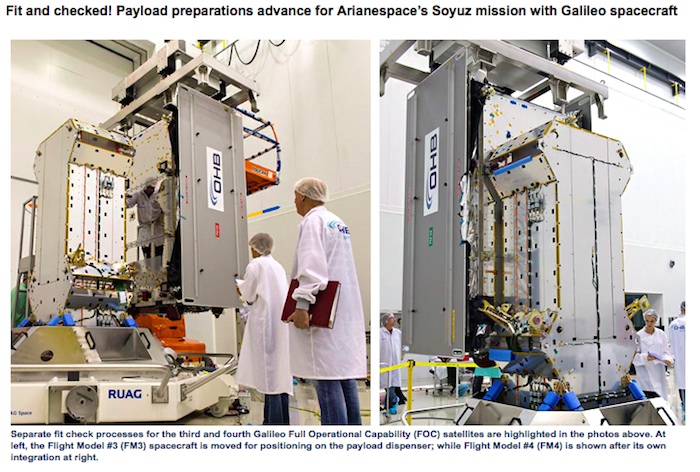
Soyuz Flight VS11
The third and fourth Galileo Full Operational Capability (FOC) satellites are a confirmed “fit” for their Arianespace Soyuz launch in March, having made initial contact with the mission’s dual-payload dispenser in French Guiana.
This week’s activity – which is called the fit check – was completed over a two-day period inside the Spaceport’s S1A payload preparation building. The two satellites were installed separately, with the Flight Model #3 (FM3) spacecraft integrated on – and subsequently removed from – the dispenser on Monday. Flight Model #4 (FM4) underwent the same process the following day.
The payload dispenser for Galileo was developed by RUAG Space Sweden for Arianespace, and carries one satellite on each side. It will deploy the spacecraft during their Soyuz launch by firing a pyrotechnic separation system to release them in opposite directions at the orbital insertion point.
Final integration on the dispenser is to be performed during upcoming processing at the Spaceport, and will be followed by the completed unit’s installation on Soyuz.
This March 27 mission – designated Flight VS11 in Arianespace’s numbering system – will be the company’s fourth launch carrying spacecraft for the Galileo constellation, which is Europe’s initiative for a satellite-based navigation system. FM3 and FM4 were built by OHB System, with Surrey Satellite Technology Ltd. supplying their navigation payloads.
The Galileo network’s complete operational and ground infrastructure will be deployed during the Full Operational Capability phase, which is managed and funded by the European Commission. The European Space Agency has been delegated as the design and procurement agent on the Commission’s behalf.
Quelle: arianespace
.
Update: 6.03.2015
.
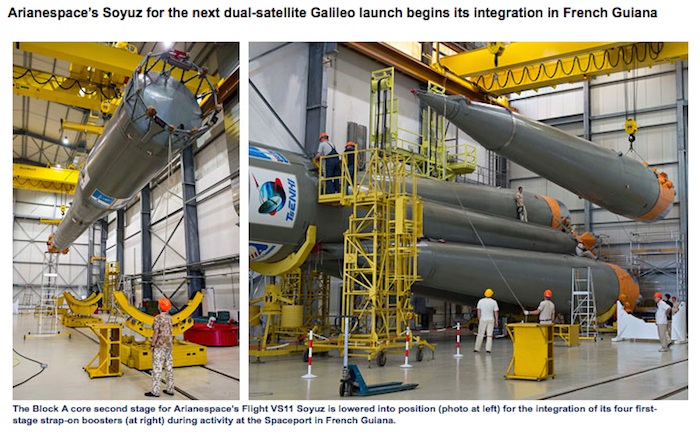
Soyuz Flight VS11
The Soyuz launcher for Arianespace’s upcoming mission with two European Galileo navigation satellites is taking shape at the Spaceport for a March 27 liftoff from French Guiana.
During activity in the Spaceport’s Soyuz Launcher Integration Building, the medium-lift workhorse began to assume its iconic form with integration of the four first-stage strap-on boosters to the Block A core second stage.
The next step will be the mating of Soyuz’ Block I third stage to the launcher’s core, completing the basic build-up, and readying the vehicle for its rollout to the launch pad – where the payload will be mated.
Arianespace’s March 27 flight will be the 11th Soyuz flight from French Guiana since the launcher’s introduction at the Spaceport in October 2011. It is designated Flight VS11 in Arianespace’s numbering system for its launcher family – which also includes the heavy-lift Ariane 5 and lightweight Vega.
For the upcoming Soyuz mission, Arianespace will loft the third and fourth Galileo Full Operational Capability (FOC) satellites to further expand the constellation for Europe’s space-based navigation system. Flight VS11’s two satellites were built by OHB System, with Surrey Satellite Technology Ltd. supplying their navigation payloads.
Galileo’s complete operational network and its ground infrastructure will be deployed during the program’s Full Operational Capability phase, which is managed and funded by the European Commission. The European Space Agency has been delegated as the design and procurement agent on the Commission’s behalf.
Quelle: arianespace
.
Update: 9.03.2015
.
Galileo Satelliten bereit für die Betankung zum Start
All the elements for this month’s Galileo launch are coming together at Europe’s Spaceport in French Guiana. As the two satellites undergo final testing and preparations, the first part of their Soyuz launcher has also been integrated.
Assembly of the Soyuz ST-B’s first two stages, plus its four first stage boosters, took place at the Spaceport’s Soyuz Launcher Integration Building last week. Assembly takes place on a horizontal basis, in the Russian manner.
The next step will be the addition of the third stage, then the main part of the launcher will be complete, ready to be transported to the Soyuz launch pad and moved to the vertical position.
The final fourth stage of the Soyuz is the reignitable Fregat, which will transport the two satellites to their final 23 222 km altitude medium Earth orbit. This will be attached to the Soyuz on the launch pad, once the satellites, their dispenser and launch fairing have been mounted on it.
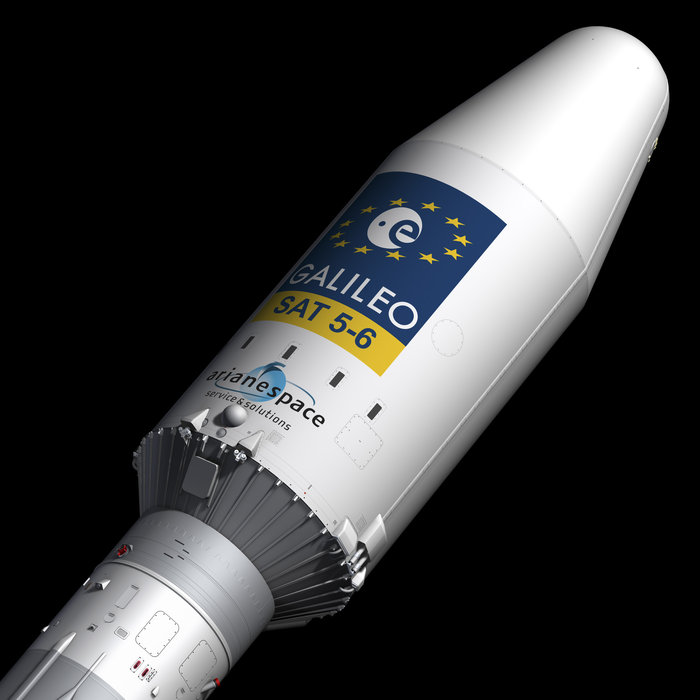
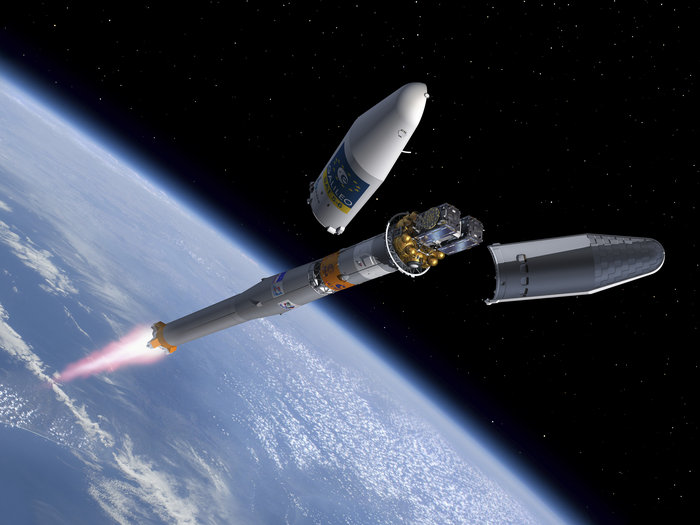
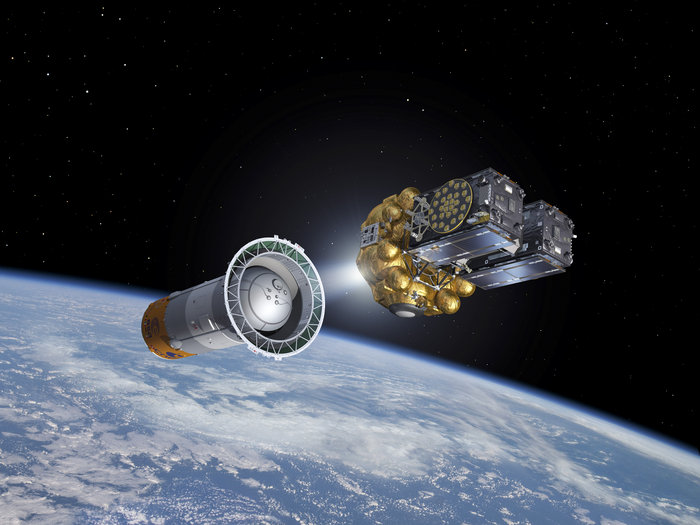
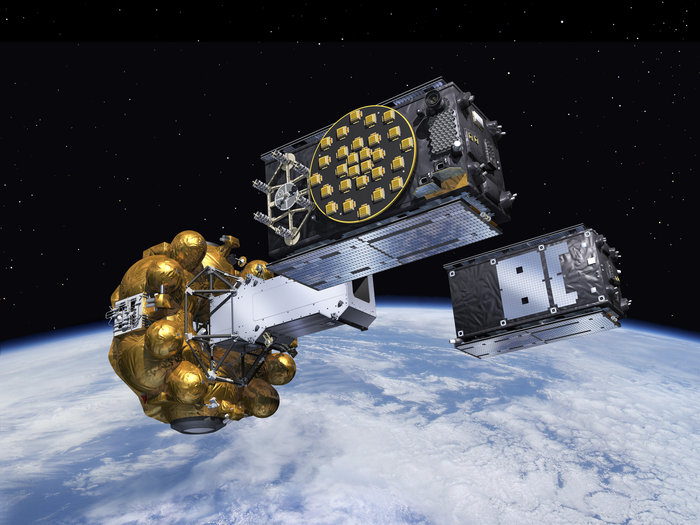
Since the seventh and eighth Galileo satellites arrived in French Guiana last month, they have undergone several tests – including one System Compatibility Test Campaign each, where they are linked up to the rest of the global Galileo ground segment as if they are already ‘live’ in orbit.
The all-important ‘fit check’ was passed in the middle of February. The two satellites were installed separately onto their dual-launch dispenser, to check they fitted correctly.
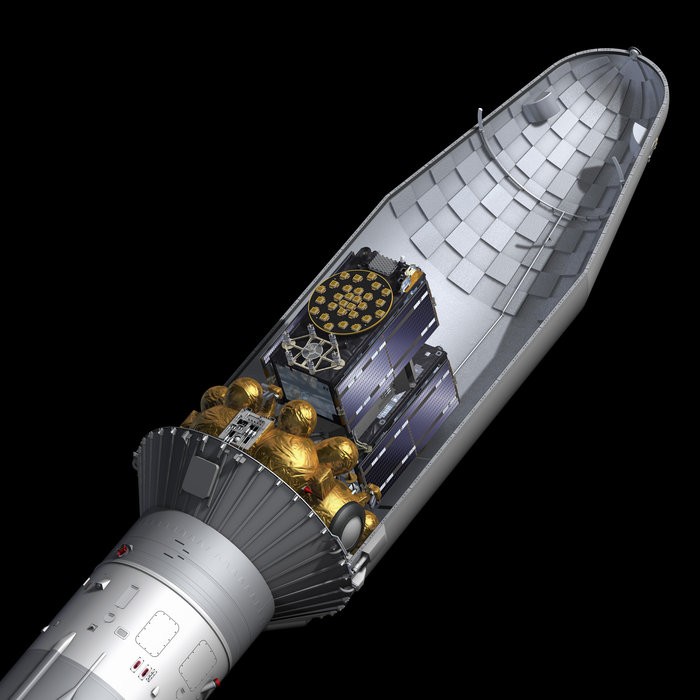
This dispenser has the task of holding them in place atop the Fregat during the launch and flight to their final orbit, then releasing them. They will be installed together later this month, after the satellites have been fuelled.
Last week saw the finalisation of their hardware and software, and the charging of their batteries – on which the satellites will be reliant from the short but crucial period from their launch to the unfurling of their solar arrays in orbit.
The pair of satellites is now ready to be transferred to the Spaceport’s S5A fuelling facility, where they will receive the fuel to keep them controllable during their 12-year working lives.
After their fuelling and final check, the pair of satellites will be in launch configuration. After a final review they will then become available for Arianespace teams to carry out the final preparation, known as Combined Operations, leading to the launch day.
The launch of the seventh and eighth Galileo satellite will take place on Friday 27 March.
-

Cutaway view of the Soyuz rocket fairing carrying a pair of Galileo satellites.
.

Artist's view of the Soyuz rocket fairing carrying the first two Full Operational Capability satellites (SAT 5-6).
The pair will be launched together aboard a Soyuz rocket, joining the four Galileo satellites already in orbit. The launch is set for summer 2014, from Europe's Spaceport, French Guiana.
The definition, development and in-orbit validation phases of the Galileo programme were carried out by ESA and co-funded by ESA and the EU.
.

Artist's view of the Soyuz rocket fairing carrying the first two Full Operational Capability satellites (SAT 5-6).
The pair will be launched together aboard a Soyuz rocket, joining the four Galileo satellites already in orbit. The launch is set for summer 2014, from Europe's Spaceport, French Guiana.
The definition, development and in-orbit validation phases of the Galileo programme were carried out by ESA and co-funded by ESA and the EU.
.

Artist's view of the fifth and sixth Galileo satellites on their Fregat upper stage separating from the Soyuz upper stage, some 9 minutes and 23 seconds after launch. The Fregat flew them the rest of the way up to medium-Earth orbit.
The first two Galileo Full Operational Capability satellites (satellites 5-6) were launched together aboard a Soyuz rocket from Europe's Spaceport in French Guiana on 22 August 2014, joining the four Galileo satellites already in orbit.
The definition, development and in-orbit validation phases of the Galileo programme were carried out by ESA and co-funded by ESA and the EU.
.

The Fregat upper stage flew the fifth and sixth Galileo satellites most of the way up to medium-Earth orbit, having separated from the third stage of the Soyuz at 9 minutes and 23 seconds after launch.
The first two Galileo Full Operational Capability satellites (satellites 5-6) were launched together aboard a Soyuz rocket from Europe's Spaceport in French Guiana on 22 August 2014, joining the four Galileo satellites already in orbit.
The definition, development and in-orbit validation phases of the Galileo programme were carried out by ESA and co-funded by ESA and the EU.
Quelle: ESA
-
Update: 15.03.2015
.
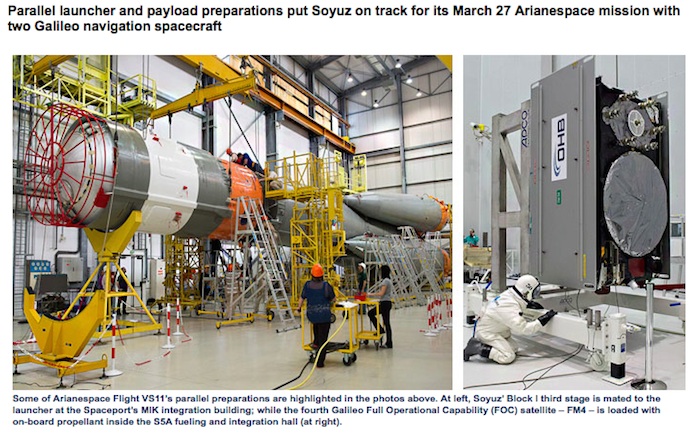
Soyuz Flight VS11
Preparations for Arianespace’s next Soyuz flight are in full swing at multiple locations across the Spaceport, including a key integration step for the medium-lift launcher, plus the start-up of fueling for its Galileo satellite passengers.
Soyuz’ Block I third stage was mated to the vehicle’s core during activity today in the MIK Launcher Integration Building, concluding its basic build-up. Once the checkout process is completed, Soyuz will be transferred to the launch pad – where it will receive the two Galileo spacecraft and the Fregat upper stage, all of which are well into preparation phases of their own.
Payload fueling commenced earlier this week, with Flight Model #4 (FM4) – the fourth Galileo Full Operational Capability (FOC) satellite – receiving its propellant load in the Spaceport’s S5A fueling and integration hall. After its “sister” FM3 co-passenger undergoes this same process, the two will be integrated side-by-side on a dispenser for their shared ride aboard Soyuz on March 27.
The fueling process followed the finalization last week of FM3 and FM4’s hardware and software, as well as the charging of their batteries – which will be relied upon during the short period from launch to unfurling of these spacecraft’s solar arrays in orbit.
The Galileo program is Europe’s initiative for satellite navigation, providing a highly accurate global positioning system under civilian control – to consist of 30 satellites in total, along with European control centers and a worldwide network of sensor and uplink stations.
Galileo’s FOC phase – during which the network’s complete operational and ground infrastructure will be deployed – is managed and funded by the European Commission, with the European Space Agency delegated as the design and procurement agent on the Commission’s behalf.
The FM3 and FM4 spacecraft were built by OHB System in Bremen, Germany. Their navigation payloads, which will generate the precision positioning measurements and services to users worldwide, were supplied by Surrey Satellite Technology Ltd. in Guildford, UK.
This upcoming mission is designated Flight VS11 in Arianespace’s numbering system. It will be the company’s fourth launch carrying spacecraft for the Galileo constellation, as well as the 11th flight of a workhorse Soyuz from French Guiana since the 2011 introduction.
Quelle: arianespace
.
Update: 18.03.2015
.
Getting ready for launch: Payload integration is underway for Soyuz’ Galileo passengers
Soyuz Flight VS11
The two Galileo navigation satellites for Arianespace’s upcoming medium-lift flight have “joined up” with their payload dispenser system – a key step in the preparations for this March 27 mission.
.
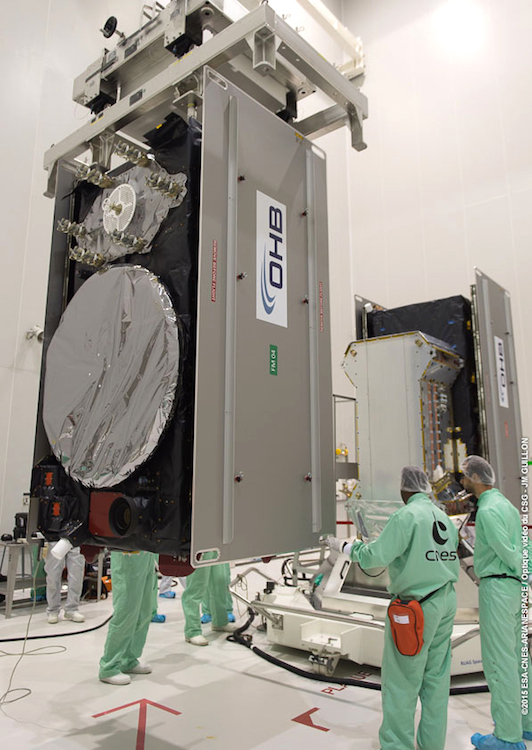
One of Soyuz’ Galileo navigation satellite passengers is already installed on the payload dispenser system (seen in the background), as the second spacecraft is moved into position for its integration.
.
During activity at the Spaceport’s S5A preparation hall in French Guiana, the Galileo Full Operational Capability (FOC) spacecraft were mounted on their two-sided dispenser system, readying them for integration on Soyuz’ Fregat upper stage and encapsulation in the payload fairing. These steps will create the “upper composite,” which is installed atop Soyuz once the workhorse vehicle is moved to its Spaceport launch zone.
Designated Soyuz Flight VS11 in Arianespace’s numbering system, Soyuz’ 11th launch from the Spaceport in French Guiana is planned for an evening liftoff on March 27 at precisely 6:46:18 p.m. local time.
On this mission, Arianespace’s medium-lift launcher will carry out a nearly 3-hour, 48-minute mission to place its Galileo passengers into a targeted circular orbit at an altitude of 23,522 km., inclined 55.04 degrees to the equator.
Soyuz Flight VS11’s passengers are the latest FOC satellites in the Galileo program, which will create a European-operated space-based navigation system. Providing a highly accurate global positioning system under civilian control, the complete Galileo constellation will consist of 30 satellites in total, along with European control centers and a worldwide network of sensor and uplink stations.
The European Commission is managing and funding Galileo’s FOC phase – during which the network’s complete operational and ground infrastructure will be deployed. The European Space Agency has been delegated as the design and procurement agent on the Commission’s behalf.
The FOC spacecraft to be lofted on Soyuz Flight VS11 were built by OHB System in Bremen, Germany, with their navigation payloads supplied by Surrey Satellite Technology Ltd. in Guildford, UK.
.

Quelle: arianespace
.
Update: 24.03.2015
.
Final payload integration process begins for this week’s Arianespace Soyuz launch from the Spaceport with two Galileo spacecraft
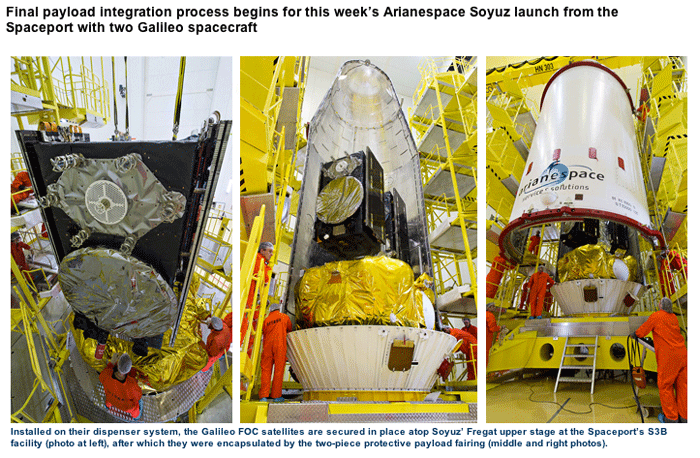
Soyuz Flight VS11
The payload build-up has been completed in French Guiana for Arianespace’s medium-lift Soyuz mission on March 27, which is to orbit the third and fourth Full Operational Capability (FOC) satellites for Europe’s Galileo navigation system.
These latest preparations – which occurred in the Spaceport’s S3B clean room facility – involved installation of the two Galileo spacecraft with their dispenser system atop Soyuz’ Fregat upper stage, followed by encapsulation in the two-piece protective payload fairing.
The completed unit, called the “upper composite,” will be mated atop Soyuz after the workhorse vehicle’s rollout from the MIK integration building – where launcher assembly is handled – to the launch zone.
Scheduled for liftoff on March 27 at precisely 6:46:18 p.m. local time in French Guiana, Soyuz will carry out a nearly 3-hr., 48-min. mission from launch to separation of the two Galileo satellite passengers. Fregat – which is responsible for the final orbital maneuvers – will perform two burns separated by a three-hour-plus ballistic phase to reach the targeted deployment point.
Galileo is Europe’s initiative for satellite navigation. Its complete operational and ground structure will be deployed during the FOC phase, which is managed and funded by the European Commission, with the European Space Agency delegated as the design and procurement agent on the Commission’s behalf.
OHB System built the Galileo FOC satellites for launch by Soyuz, while Surrey Satellite Technology Ltd. supplied their navigation payloads.
The upcoming mission is designated Flight VS11 in Arianespace’s numbering system, and will mark the company’s fourth launch to date carrying Galileo spacecraft.
Quelle: arianespace
.
Update: 26.03.2015
.
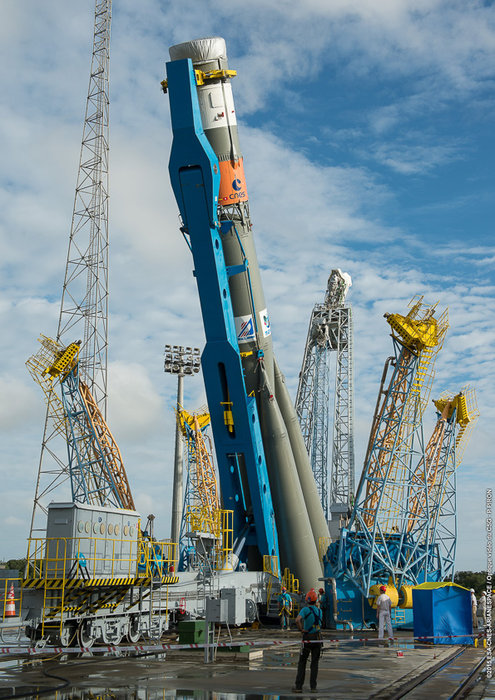
Thousands of engineers have worked on the seventh and eighth navigation satellites of Europe’s Galileo constellation in recent years, but last Friday marked the very last time the spacecraft were glimpsed by human eyes.
The team from ESA and builders OHB in the S3B building of Europe’s Spaceport in French Guiana looked on as the focus of their work disappeared from view.
The pair of satellites – already resting atop their Fregat upper stage and attached to their dispenser – was enclosed within the halves of the Soyuz rocket’s protective fairing.
This unit was moved yesterday to the launch site, where it will be lifted atop the first three stages of the Soyuz ST-B to complete the vehicle for Friday’s launch.
Last week saw the two satellites being fuelled in the Spaceport’s S5A preparation hall and then brought together atop the dispenser that will support them during the rigours of ascent.
The dispenser’s final task is to release them in opposite directions once their 22 522 km-altitude orbit is reached. The satellites themselves will then gradually lower themselves to their working 22 322 km orbit.
After fuelling, the satellites plus dispenser were moved to the S3B processing building, where their Fregat was already fuelled and waiting.
.
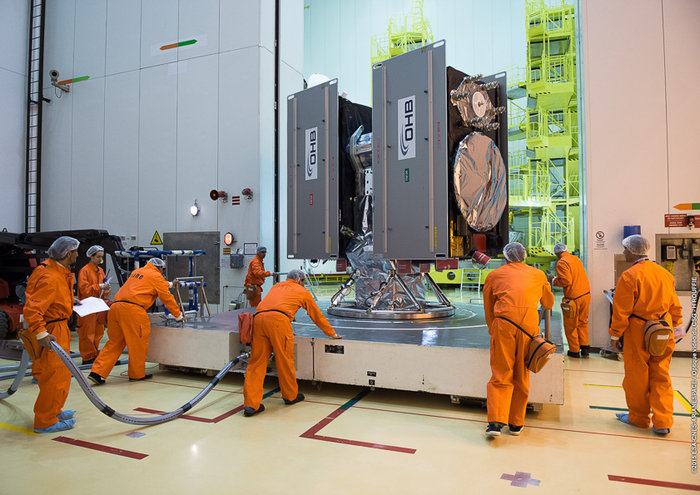
The reignitable Fregat is as much a spacecraft as a rocket stage. Once the Soyuz reaches low orbit, Fregat will take over the task of hauling the satellites higher through a pair of burns.
The two Galileos and their dispenser altogether weigh more than one and a half tonnes, so the attachment operation took place with great care and precision.
Then the fairing halves were slowly slid into place around them and closed. Enclosed in this way, the satellites will be protected from the harsh slipstream and vibration of the first few moments of launch, when the Soyuz is still travelling through the thickest layers of atmosphere.
The fairing is due to be ejected 3 min 29 sec after liftoff.
Until liftoff, the satellites remain connected to the outside world via power and data links, allowing ESA’s Galileo team keep a check on their battery charging and the health of their atomic clocks.
The satellites stay switched off during launch, and will be activated automatically on separation from the dispenser.
Launch is due at 21:46:18 GMT (22:46:18 CET, 18:46:18 local time) on 27 March. The satellites are scheduled for release upon reaching their set orbit 3 h 47 min 57 sec after launch.
.
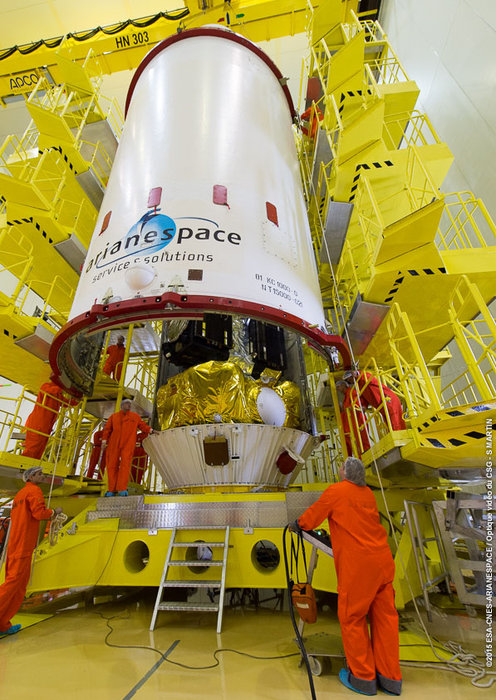
Quelle: ESA
---
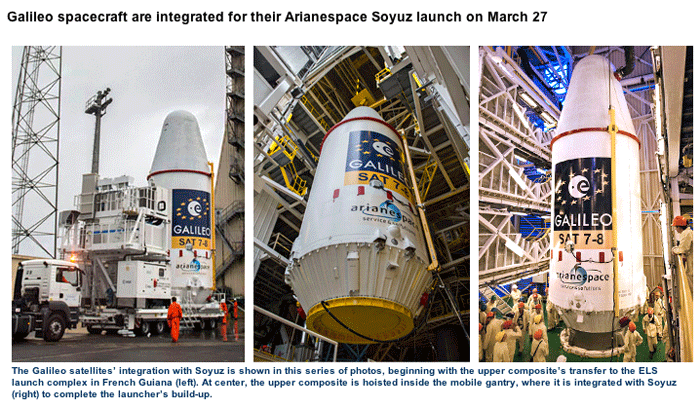
Soyuz Flight VS11
The next medium-lift Soyuz to be launched from French Guiana is now complete following the integration of its “upper composite” – which consists of two Galileo satellite passengers, their protective payload fairing and the Fregat upper stage.
This activity was performed at the Spaceport’s ELS launch complex. It began with the upper composite’s transfer yesterday from the S3B payload preparation facility to the launch pad on a special transporter, and was followed by its hoisting to the upper level of a purpose-built mobile gantry – which provides a protected environment for the vertical installation atop Soyuz.
Final checkout of the completed launch vehicle is now underway, leading up to the Arianespace liftoff that is planned on Friday, March 27 at precisely 6:46:18 p.m. local time in French Guiana.
The mission’s payload – a pair of Full Operational Capability (FOC) spacecraft that will further expand Europe’s Galileo global navigation satellite system – are to be deployed during a flight lasting approximately 3 hrs., 47 min.
OHB System built the two spacecraft in Bremen, Germany as prime contractor. Their navigation payloads, which will generate the precision positioning measurements and services to users worldwide, were supplied by Surrey Satellite Technology Ltd. in Guildford, UK.
Galileo’s FOC phase – during which the network’s complete operational and ground infrastructure will be deployed – is being managed and funded by the European Commission, with the European Space Agency delegated as the design and procurement agent on the Commission’s behalf.
.


Quelle: arianespace
.
Update: 27.03.2015
.
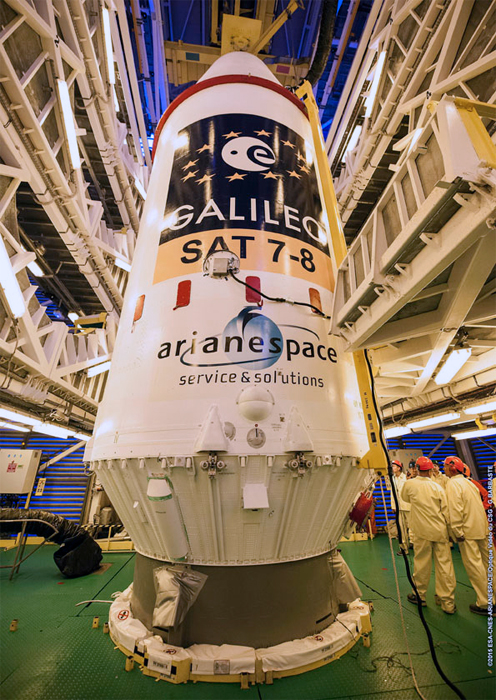
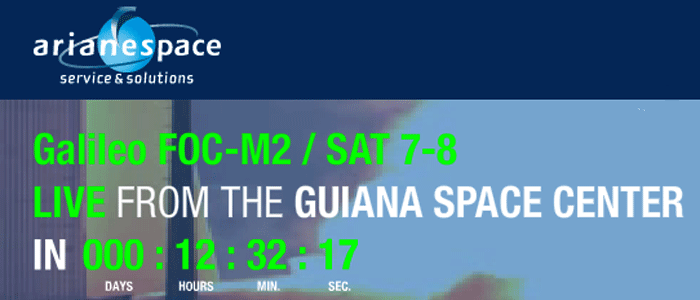
Quelle: arianespace
...
Update: 23.00 MEZ: Erfolgreicher Start
.
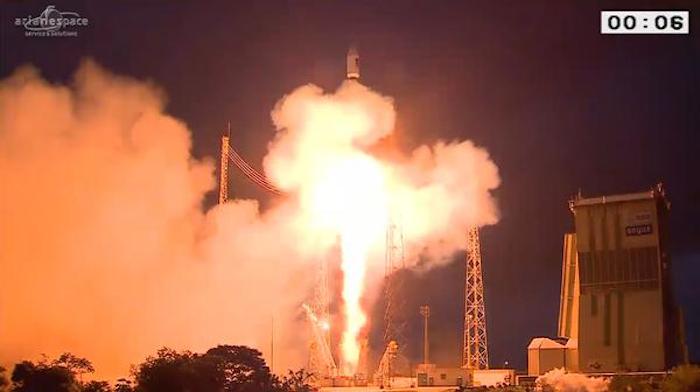
Quelle: arianespace
4818 Views
